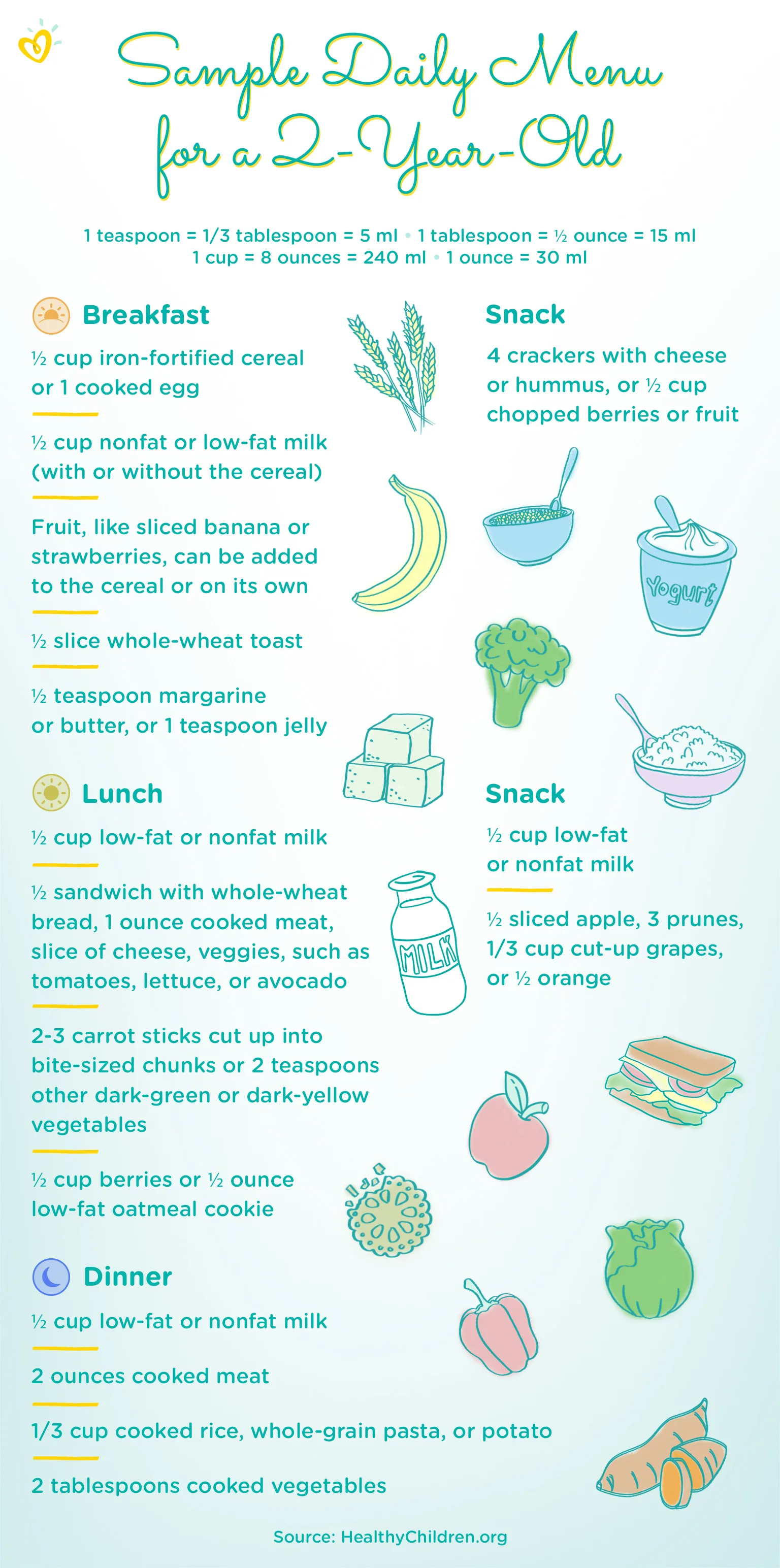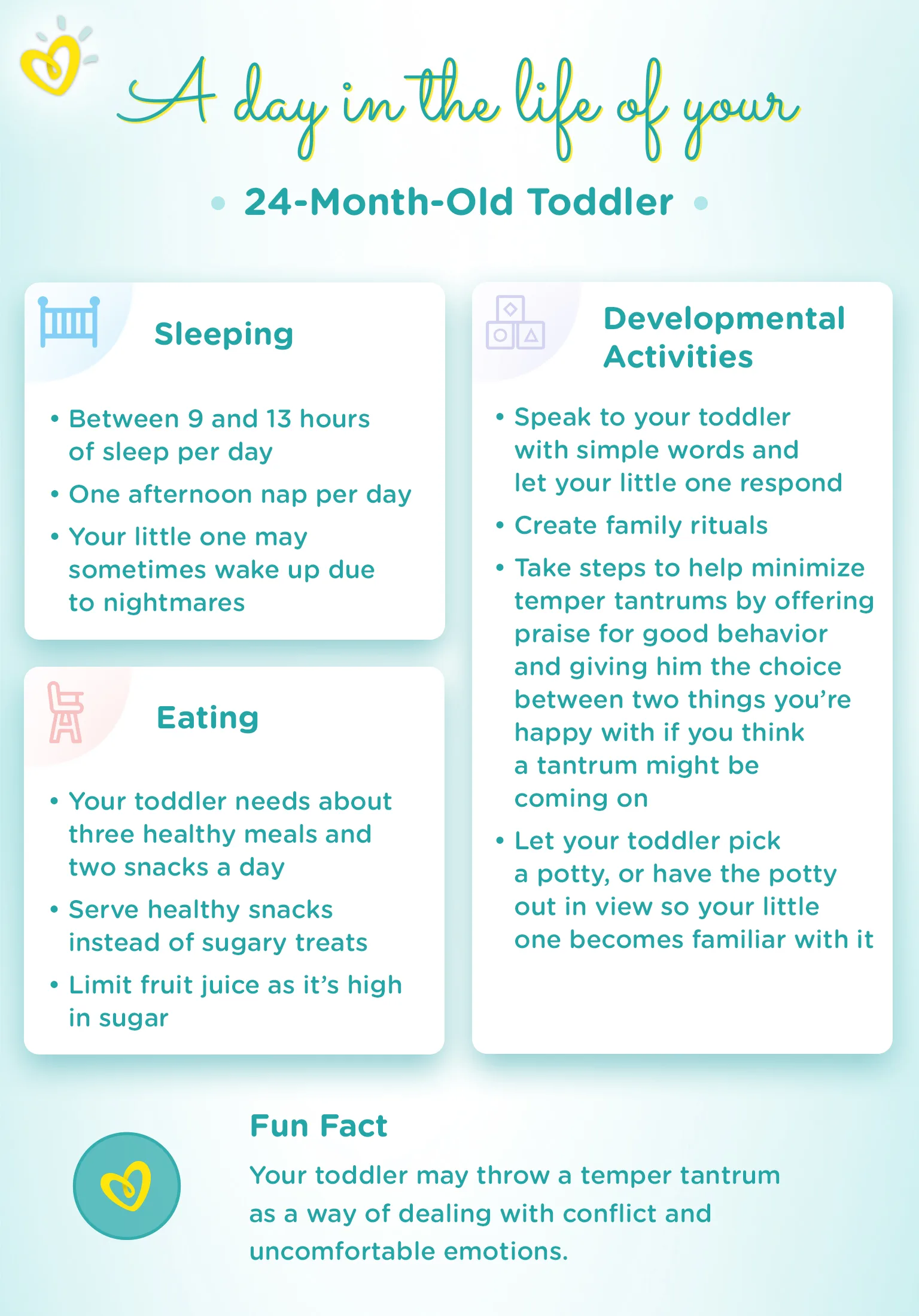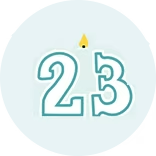24 Months Baby: Turning 2!
Congratulations! Your toddler is now a 2-year-old! Although you might have been through the “terrible twos” and those infamous temper tantrums, so many other exciting things are going on in your toddler’s life that more than make up for these challenges. Now is a time to start creating family rituals together that will create great memories for you to cherish.
2-Year-Old Milestone
No two 2-year-olds are quite the same, and your little one will continue to develop at his own pace. However, here's a developmental checklist for 2-year olds:
Tantrums:
There is a reason why 2-year-olds get such a bad rep. Around this age, your 2-year-old may throw a tantrum when you ask him to stop doing something he enjoys (because it's lunchtime or bedtime), or he may put up a fuss when he doesn’t get something he wants at the grocery store. Welcome to the “terrible twos.” Your child is probably feeling a lot of emotions he can't handle or even express right now, and tantrums often occur when he can’t get his way (remember, your toddler, like all toddlers, thinks the world is all about him). Tantrums are perfectly natural at this age, and almost all children will have them occasionally, especially when they're tired or hungry.
Expanded vocabulary:
Thanks to a rapidly increasing vocabulary, your child may be able to say a bunch of words by now. He may also be able to use a few simple two- to four-word sentences. When you name a familiar object or person, your 24-month-old may recognize it and point to it.
Confident walking:
Look who's walking like an expert now! In the coming months, your child may even start to run. Before you know it, you’ll be struggling to keep up!
Improved motor skills:
Your 2-year-old might be able to kick a ball, climb up and down furniture unassisted, or carry a large toy or several smaller toys around while walking. Seeing this shows you that your toddler’s ability to coordinate and control his arm and leg movements is improving.
Support Your 2 Years Old Baby's Development
These are a few steps you can take to help foster your 2-year-old’s development:
Speak to him clearly and with simple words:
He may even reply to you with simple words of his own, and you may be starting to have little conversations.
Create some family rituals:
Routines help your little one feel safe and secure, so why not create a few family rituals? You can get your little one more involved with traditions your family already has, or create new ones together, like scheduling a weekly walk in the park, a weekend family dinner, or singing and reading together every Thursday evening.
Consider starting potty training:
Now that your little one is 2 years old; he may be ready to start toilet training. Signs of readiness include showing an interest in using the potty, letting you know that he needs to go, and being able to pull his pants down and pull them back up again. Even if he’s not quite ready yet, you can start to introduce the concept to him—maybe let him choose a potty that he likes, keep the potty in a place where he can see it, and explain how it works. In the meantime, you can also read up on, so you feel more prepared for what’s to come.
Take steps to handle temper tantrums:
Try not to take temper tantrums personally and avoid feeling embarrassed by them—everyone who’s had a toddler will know this period all too well. In the meantime, you can help your little one through this period by offering praise for good behaviour and providing distraction when possible.
Tell your child a story:
You could start with something that happened in your own childhood or think of a character your child would like (maybe a favourite animal), and then give free rein to your imagination. As he listens, your child is learning about structure—that stories have a beginning, a middle, and an end. If you've always wanted to be an actor, have at it! Your voice and your facial expressions are nearly as important as the words in your story.
Mealtimes and Menus for Your 2-Year-Old Child
Your 24-month-old toddler needs a variety of healthy foods. Offer him three small meals and two snacks a day with plenty of vegetables, fruit, dairy, protein, and whole grains in the mix.
It’s never too early to teach your little one some good habits. Although, at 2 years old, he may be too little to behave perfectly at the table, here are some ways you can introduce good table manners and healthy habits:
Have family meals:
Sit down at the table together at least once a day for a family meal. Turn off the TV and put away the devices. Take this opportunity to discuss the day and involve your toddler in conversations—even if he isn’t saying much yet, he may be paying more attention than you think.
Eat healthily yourself:
If your toddler sees you eating and enjoying all kinds of nutritious foods, he’ll be more likely to want to try the healthy foods you offer him as well.
Teach good table manners:
Although he’s still too young to be expected to say please and thank you on a regular basis, you can begin by setting a positive example and using “please” and “thank you” with your partner or older children. You can also encourage your little one not to talk with his mouth full, or to close his mouth while chewing. Even just mentioning these occasionally helps set the ground rules for what you would like him to learn later on.
Treat dinnertime as a ritual:
Perhaps assign a specific time for the meal, set the table, and have all the family sit around together without any phones or distractions. This is a wonderful opportunity to bring the family together and ensures your little one is likely to look forward to dinner as a special family time.
Meal Ideas for 2-Years Baby
Not sure what to serve your 24-month-old? Check out these meal ideas for breakfast, lunch, dinner, and snacks:
Sleep Schedule for 24-Month-Old
When your little one is 2 years old, he may sleep around 9 to 13 hours per day. However, he may still need an afternoon nap, which might be around two hours long.
Nightmares and Night Terrors
You may wake up to your little one calling out your name from his bedroom, or to screams or cries in the middle of the night. These nightmares or night terrors can be upsetting for him and worrying for you, and you may be wondering what is happening.
A nightmare is a frightening dream that often takes place during the second half of the night, during the most intense stage of dreaming. When your little one has a nightmare, he may wake up crying or feeling scared, and may have trouble falling back to sleep, especially if he remembers what the nightmare was about.
Night terrors are a little different. These tend to happen earlier in the night, during the deepest stages of sleep, and in fact your child won't be fully awake (even though it looks like he's awake). During a night terror, your child may:
Cry uncontrollably
Shake, sweat, or hyperventilate
Have a terrified look in his eyes
Thrash around, kick, scream, or stare
Not recognise you are there
Push you away, especially if you try to touch him.
Night terrors can last up to 45 minutes, but more often than not, they are much shorter. Because your little one does not wake up fully during a night terror, he can fall back into deep sleep more easily and may not remember that he's had one. Here are guidelines to follow when your little one has a night terror:
Stay calm
Do not try to wake your child
Make sure he cannot hurt himself; if he tries to get out of bed, try to restrain him and keep him away from any harmful objects
Keep in mind that your child will relax and sleep quietly afterward. If your child tends to have night terrors, it's a good idea to let babysitters know ahead of time that these might occur and to provide guidance on what to do.
Dealing with Nightmares and Night Terrors
Although you can't do much to prevent nightmares or night terrors completely, you can follow these steps and try setting up your toddler for a good night’s sleep:
Maintain a regular sleep schedule:
Common triggers like stress and overtiredness can lead to bad dreams. Try keeping a consistent sleep schedule as much as possible - meaning keep the naptime and bedtime at the same time every day and follow a calming routine before bed as well.
Attend your child quickly if he sounds distressed:
Although rushing to your toddler’s crib if he’s just fussy is not something you would do, go to him immediately if he wakes you up after a bad dream and calls out your name in distress or you hear him screaming.
Let him know he is safe:
Assure your toddler that there is nothing out there that will hurt him and that he is safe.
Ask him to recall his dream and remind him it’s not real:
Help your toddler understand that dreams are not real, and everything is alright.
Keep the light on:
If your toddler feels safer, then it's OK to keep the light on. Let him sleep with a night-light on or with the door open a little, letting some light from the hallway in.
Check if anything scares your child:
See if there are any creepy-looking shadows or items that may make your little one uncomfortable and try to remove them.
A Day in the Life of Your Toddler
Now that you have a 2-year-old, here’s what a day in your home might look like:
Water Safety
When it comes to playing in or near water, you need to be particularly vigilant to keep your toddler safe and reduce the risk of drowning. Here are some water safety tips:
An adult must be there to supervise. Whether your little one is learning to swim, splashing in a shallow pool, or simply taking a bath, you or another responsible adult must be there to watch her at all times.
Pay constant attention. Avoid distractions like reading or using your phone, even if a lifeguard is present.
Get in the water with her. If she is in the water paddling or learning to swim, get in the water with her and keep close by, within arm's distance.
If you cannot supervise, assign a responsible adult to keep an eye on your toddler. Never leave the responsibilities of watching your toddler to a child.
Use life jackets. If you’re on a boat on a lake, sea, or river, or you’re doing activities close to the water, make sure your little one has a life jacket on that fits.
If you have a pool, make sure it is fenced on all sides and that the gate is closed at all times. Keep your toddler out of the pool area if she is unsupervised.
Empty the wading pool after use. A wading pool can be fun for your little one, but if you do use one, ensure you empty it after use and put it away.
FAQs at a Glance
Each toddler develops at her own rate, but at this point, or sometime soon in the coming year, your child may be able to understand most sentences, do simple puzzles with three or four pieces, play make-believe, and run. However, don’t worry if you don’t notice any or all of these just yet—as each toddler is unique and develops at her own pace.
Handling Tantrums as a Parent
You might have been told about the frequent temper tantrums that can erupt around now. Seeing your normally good-tempered child suddenly screaming, kicking, fist pounding, and more can shock you.
Keep in mind, tantrums are just a way for your toddler to deal with conflict or emotions like anger, fear, and frustration he’s unable to articulate. At this age, most toddlers feel like the world revolves around them, so your toddler may act out when things don't go his way. This may also be a reason behind the tantrum.
Using the following strategies, you can minimize these tantrums:
Make requests using a friendly tone and polite words. Avoid stern-sounding commands as much as possible when asking your child to do something. Instead, use a cheerful tone and words like “please” and “thank you”, which are more effective in getting her to cooperate.
Avoid overreacting when she says “no," as for many toddlers, "no" is a favourite word and is used automatically to respond to any request. So, don't be surprised if this happens in your house. Your toddler may even say it when he means otherwise (like when you offer ice cream) to show he is in control. Simply repeat your request in a calm and clear manner, and don’t punish her for saying no.
Distract your toddler. As he has a short attention span, try to use it to your advantage by offering something else quickly before he throws a tantrum. Try starting a new activity or changing the environment by moving her to a new room.
Reward good behaviour. Offer plenty of praises and attention when she does something right or behaves well, even if it means spending extra time with her as she quietly plays or reads.
Anticipate tantrum triggers. For example, leave your toddler at home if possible if she tends to make a scene at the grocery store. As time passes, you may notice her tantrum triggers. You can then try to avoid or prepare for them by having a distraction up your sleeve.
Pick your battles. When it comes to safety, like putting the seat belt on, it’s worth fighting with her. However, if she simply wants to wear a different coloured top, it's not worth the fight.
Give your toddler choices. One of the simplest ways is to offer two choices (you are happy with) to your toddler and let her pick. This will help prevent some tantrums. For example, rather than asking her to wear a jacket, you can give her options to wear two sweaters or a jacket. You can also let her decide to wear her jeans or her overalls





